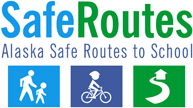Get Involved
IDEAS FOR ENCOURAGING SCHOOLWIDE PARTICIPATION
adapted from NHTSA Safe Routes to School Promotional Toolkit and from the National Safe Routes to School Guide
Contests
Contests can encourage students to change their behavior and try new activities and ideas. They can be a fun way to encourage and keep students motivated. However, be careful with the timeline of a contest. A yearlong contest might cause students to lose interest or enthusiasm. Keep students interested with a variety of changing themes throughout the year.
Art
Art contests give children the opportunity to develop safety slogans and art while learning about better safety practices. Their artwork can then be used as signs or banners as part of a community-wide safety campaign. Students in Hertfordshire, England saw their own artwork transformed into “gateway” signs to alert drivers entering roads around schools.
Essays
Essay and creative writing contests give students an opportunity to address how transportation affects their community and the environment. Middle school students at the Lagunitas School in Marin County, California, met with school instructors to develop an essay that looked at two different scenarios. What would the world be like in 20 years if everyone drove as much as Americans? They were then asked to contemplate a world where everyone rode bikes, walked, or used transit. The outcome “Nightmares and Sweet Dreams” was a thought-provoking essay on the choices the students face in their future. The essay was published in a number of different newsletters.
Treasure Hunt
Create a list of objects, safety signs, and special landmarks and ask the children to locate them on their walk to school. Those who find all the items win a prize.
Classroom Game Board
Students at Hawthorne School in British Columbia created a classroom game board. Every time the majority of the class walked or biked to school, they stamped a square on the board. When the whole board was complete, the class qualified for a class prize.
Mileage club
Mileage clubs and contests encourage children either to begin walking and bicycling to school or to increase their current amount of physical activity by making it fun and rewarding. Generally children track the amount of miles they walk or bicycle and get a small gift or a chance to win a prize after a certain mileage goal is reached.
Mileage clubs and contests are usually designed in one of three ways:
- On an individual basis where every child logs miles walked or bicycled and has a chance to win;
- As a classroom competition where a classroom’s collective miles are compared against other classes; or
- As a competition among schools.
Winners are rewarded with prizes including medals, certificates or trophies.
In cases where students cannot walk or bicycle to school because of safety concerns, distance, or disability, the school can provide credit for distance walked and bicycled at home, to and from a bus stop, or during the school day on campus.
In order to be most effective, incentives need to be provided in concert with other strategies over a period of time – not just given once.
Other Activities
Walking Club
An afterschool, on-campus club is a great way to encourage active lifestyles in children. Especially helpful for students who are unable to walk to school because of distance or safety reasons, Walking Clubs offer students a chance to be part of a school-wide effort to increase physical activity and reduce obesity. These clubs allow students to partake in different walking related contests and activities, such as a Mileage Club, so that they too can be part of the fun!
Walk-a-thon
A walk-a-thon is a way to promote walking and raise funds at the same time. Children solicit pledges for every mile they walk (or bike) to and from school. At the end of the period, the student who raises the most money wins a prize.
Walking Wednesday
If a Walking School Bus program does not exist at a school, promoting a weekly (or monthly) Walk to School Day can be a great alternative. Modeled after the international Walk to School Day held in October every year, students can spend one day a week (or month) enjoying the social and physical benefits of walking to school. Once established, it could be a great segue into setting up a daily Walking School Bus program.
Green Tree
In the “Way to Go” contest (British Columbia), each child comes to school and colors a leaf. The color of the leaf is determined by the child's travel mode. Walking and biking students color leaves green. Those who arrive by bus and carpool get a different shade of green leaf. If a child traveled by car part of the way, but walked at least a block, the leaf is half yellow or brown and half green. Students who arrive by car (but not in a carpool) get a brown leaf. The leaves are then mounted on a tree, and the more the children walk or bike to school, the greener the tree becomes. Give a prize to the class with the greenest tree.

